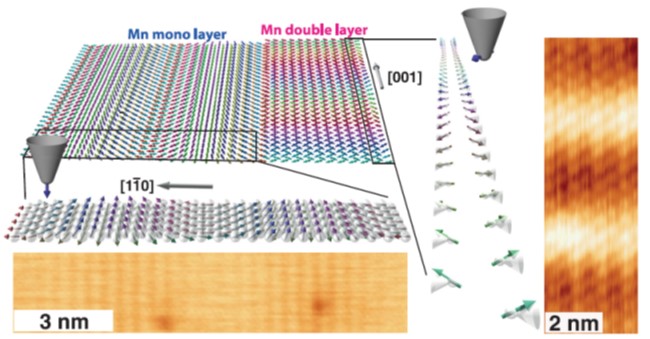
- |<
- <
- 1
- >
- >|
-
[in Japanese], [in Japanese]2017Volume 38Issue 10 Pages A2
Published: October 10, 2017
Released on J-STAGE: October 20, 2017
JOURNAL FREE ACCESSDownload PDF (85K)
-
Retsu OIWA2017Volume 38Issue 10 Pages 493
Published: October 10, 2017
Released on J-STAGE: October 20, 2017
JOURNAL FREE ACCESSDownload PDF (151K)
-
Taro HITOSUGIArticle type: Review
2017Volume 38Issue 10 Pages 494-501
Published: October 10, 2017
Released on J-STAGE: October 20, 2017
JOURNAL FREE ACCESSWhat are the frontiers of research using scanning probe microscopy (SPM)? To discuss this issue, it is crucial to understand the trends in academia, industry, and society. Based on the numbers of published articles, here, I present the trends of research using SPM. Furthermore, the prospects of SPM research are discussed.
 View full abstractDownload PDF (950K)
View full abstractDownload PDF (950K) -
Yuhki KOHSAKA, Tetsuo HANAGURIArticle type: Current Topic
2017Volume 38Issue 10 Pages 502-507
Published: October 10, 2017
Released on J-STAGE: October 20, 2017
JOURNAL FREE ACCESSSpectroscopic-imaging scanning tunneling microscopy (SI-STM) has been developed as a powerful experimental tool to analyze electronic states in extreme conditions such as very low temperatures and high magnetic fields. A salient feature of SI-STM is that the tunneling spectrum, which reflects the local density of states, is measured at every pixel of the topographic image. The obtained three-dimensional (energy and position at the surface) data set contains rich information on the electronic state at the surface. The every-pixel spectroscopy of SI-STM enables us to acquire the momentum-space information through the Fourier analyses of the quasiparticle interference (QPI) patterns. The QPI imaging allows us to study not only the energy-momentum dispersions but also the nature of the quasiparticle scattering processes. As examples of SI-STM applications, we discuss the Zeeman effect in a topological surface state and the spin-orbit scattering in a polar semiconductor.
 View full abstractDownload PDF (931K)
View full abstractDownload PDF (931K) -
 Yasuo YOSHIDA, Masahiro HAZE, Yukio HASEGAWAArticle type: Current Topic
Yasuo YOSHIDA, Masahiro HAZE, Yukio HASEGAWAArticle type: Current Topic
2017Volume 38Issue 10 Pages 508-513
Published: September 10, 2017
Released on J-STAGE: October 20, 2017
JOURNAL FREE ACCESSSpin-polarized scanning tunneling microscopy (SP-STM), which is one of the most developed probe microscopy last decades, provides spin-contrasted surface images in nano- and atomic-scale spatial resolutions. This paper introduces the technique based on our recent results performed on manganese thin films on a W(110) substrate and cobalt nano-islands formed on a Ag(111) substrate. We also provide some tips to establish SP-STM in laboratories. View full abstractDownload PDF (1373K)
View full abstractDownload PDF (1373K) -
Yoshiaki SUGIMOTOArticle type: Current Topic
2017Volume 38Issue 10 Pages 514-519
Published: October 10, 2017
Released on J-STAGE: October 20, 2017
JOURNAL FREE ACCESSMeasuring tiny inter-atomic forces has been an important challenge in the development of atomic force microscopy (AFM). Present force sensitivity achieved by a frequency modulation technique and mechanical stability of AFM allow us to quantify the inter-atomic forces atom-by-atom. We apply the capability to verify the chemical bonding theory established by L. Pauling. First, interaction forces are measured above Si adatoms and H-terminated Si adatoms on the Si(111)-(7×7) surface to compare chemical bonding force and physical force. Chemical bonding force is measured only above Si adatoms that have dangling bonds. We also systematically investigate element dependence of the chemical bonding energy. Covalent bonds are observed above group IV elements on the Si(111)-(7×7) surface while polar covalent bonds are observed above elements with different electronegativity from Si atoms. Chemical bonding energy obtained by various tip apexes can be explained by Pauling’s chemical bonding theory. View full abstractDownload PDF (678K)
View full abstractDownload PDF (678K) -
Ken NAKAJIMA, Makiko ITO, Xiaobin LIANG, Kaname MATSUEArticle type: Current Topic
2017Volume 38Issue 10 Pages 520-525
Published: October 10, 2017
Released on J-STAGE: October 20, 2017
JOURNAL FREE ACCESSNanomechanics based on atomic force microscope (AFM) is reviewed. Tapping-mode phase imaging gives information of energy dissipative process during the contact between AFM probe and elastic or viscoelastic surface, which includes adhesive interaction as well as viscoelastic loss. The understanding of time-temperature superposition principle is crucial to interpret the data correctly. AFM nanomechanics based on “slow” force-distance curve analysis can also offer a lot of insights on materials’ mechanical properties. Young’s modulus, adhesive force and viscoelastic work can be imaged. The paper devotes AFM analysis of block copolymer-type thermoplastic elastomer, in order to interconnect nanoscopic information and macroscopic mechanical properties evaluation, in which a new mathematical approach, computational homology may play an important role.
 View full abstractDownload PDF (1148K)
View full abstractDownload PDF (1148K)
-
Kota HOSONO2017Volume 38Issue 10 Pages 526-527
Published: October 10, 2017
Released on J-STAGE: October 20, 2017
JOURNAL FREE ACCESS
-
Shota KITA2017Volume 38Issue 10 Pages 528-529
Published: October 10, 2017
Released on J-STAGE: October 20, 2017
JOURNAL FREE ACCESSDownload PDF (488K)
-
Keisuke SAGISAKA, Shinya OHNO2017Volume 38Issue 10 Pages 530
Published: October 10, 2017
Released on J-STAGE: October 20, 2017
JOURNAL FREE ACCESSDownload PDF (166K) -
Takuya MATSUMOTO2017Volume 38Issue 10 Pages 531-532
Published: October 10, 2017
Released on J-STAGE: October 20, 2017
JOURNAL FREE ACCESSDownload PDF (748K) -
Ryohei KOKAWA, Keisuke SAGISAKA, Shinya OHNO, Akira CHIKAMATSU2017Volume 38Issue 10 Pages 533
Published: October 10, 2017
Released on J-STAGE: October 20, 2017
JOURNAL FREE ACCESSDownload PDF (377K)
-
2017Volume 38Issue 10 Pages 534
Published: October 10, 2017
Released on J-STAGE: October 20, 2017
JOURNAL FREE ACCESSDownload PDF (161K)
- |<
- <
- 1
- >
- >|


